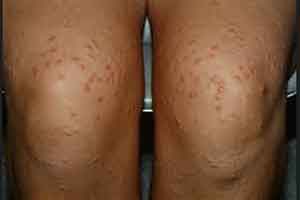- Home
- Editorial
- News
- Practice Guidelines
- Anesthesiology Guidelines
- Cancer Guidelines
- Cardiac Sciences Guidelines
- Critical Care Guidelines
- Dentistry Guidelines
- Dermatology Guidelines
- Diabetes and Endo Guidelines
- Diagnostics Guidelines
- ENT Guidelines
- Featured Practice Guidelines
- Gastroenterology Guidelines
- Geriatrics Guidelines
- Medicine Guidelines
- Nephrology Guidelines
- Neurosciences Guidelines
- Obs and Gynae Guidelines
- Ophthalmology Guidelines
- Orthopaedics Guidelines
- Paediatrics Guidelines
- Psychiatry Guidelines
- Pulmonology Guidelines
- Radiology Guidelines
- Surgery Guidelines
- Urology Guidelines
Cutaneous xanthomas in a young child: Familial hypercholesterolemia

A case of Cutaneous xanthomas in a young child diagnosed later as Familial hypercholesterolemia was reported in Indian Dermatology online Journal the details of which are as follows-
A 6-year-old, non-obese girl presented to the pediatrics outpatient department with a history of multiple, yellowish plaques, papules, and nodules over the body for past 1 year with a gradual increase in size. These lesions involved the bilateral elbow, knee, knuckle, lateral malleolus, gluteal region, and left upper eyelid and were associated with itching [Figure 1]a,[Figure 1]b,[Figure 1]c,[Figure 1]d. The nodules over the knuckles were cystic in consistency. There was absence of similar lesions and cardiovascular disease in other family members.
Complete blood count, liver, renal, and thyroid function tests were normal. Serum lipid profile showed markedly elevated levels of total cholesterol and low-density lipoprotein cholesterol level (LDL-C) viz. 803 mg/dl and 732 mg/dl, respectively. However, high-density lipoprotein cholesterol (HDL), very low-density lipoprotein cholesterol (VLDL), and triglycerides levels were normal. Chest X-ray, electrocardiogram (ECG), two-dimensional echocardiography, and fundus examination of both eyes were normal.
Fine-needle aspiration cytology (FNAC) from nodular cystic swellings over the interphalangeal joint (knuckle) revealed predominantly foamy macrophages in a hemorrhagic background. Skin biopsy from the elbow lesion showed pan dermal infiltration by foamy macrophages.
Lipid profile of her father revealed elevated serum total cholesterol (385 mg/dL) and LDL-C (271 mg/dL) levels, however, lacked clinical manifestations and other associated systemic diseases. Her mother refused to visit the hospital.
Other tests like computed tomography (CT) angiography, LDL receptor activity and genetic mutational analysis were not done due to financial constraint.
A diagnosis of homozygous familial hypercholesterolemia (HoFH) was made and medical treatment was started with statins and resins. She was recommended low fat and high fiber diet. However, follow-up after 6 months revealed no improvement in the clinical lesions and serum total cholesterol levels.
Xanthomas occur due to alteration in the lipid metabolism. Sometimes it can be the only presentation of a serious underlying lipid abnormality. In children, they are mostly associated with abnormalities of cholesterol metabolism with hypercholesterolemia and high LDL-C (Fredrickson, type II).
Familial hypercholesterolemia (FH) is an autosomal dominant genetic disorder caused by mutation in the gene encoding the receptor for LDL located on chromosome 19. FH most commonly presents as heterozygous form, becomes symptomatic in the 3rd and 6th decades, and responds well to treatment. Whereas homozygous state is rare and presents in early childhood with poor response to therapy. Early presentation in HoFH is due to persistently raised serum total cholesterol and LDL-C (>500 mg/dL) levels since birth. Children with HoFH are at risk of early-onset atherosclerosis, aortic valve disease, and premature coronary death. The diagnosis is usually made by biochemical and clinical evaluation. However, LDL receptor activity and genetic mutational analysis can also be done for further confirmation.
Genetic counselling of the family is of utmost important. Therapeutic measures include diet modification and drugs such as statins used alone or in combination with bile acid sequsterant, fibrates, and Ezetimibe.LDL apheresis and orthotopic liver transplantation are other available alternatives.
For more details click on the following link: http://www.idoj.in/text.asp?2017/8/5/375/214705

Disclaimer: This site is primarily intended for healthcare professionals. Any content/information on this website does not replace the advice of medical and/or health professionals and should not be construed as medical/diagnostic advice/endorsement or prescription. Use of this site is subject to our terms of use, privacy policy, advertisement policy. © 2020 Minerva Medical Treatment Pvt Ltd